 c160 ships 1947-1991
c160 ships 1947-1991
The Royal Canadian Navy in WW2 arrived at the world’s fourth rank in 1945, taking a pivotal role in the Battle of the Atlantic, providing 40% of the convoy escort. From this position, the navy grew with a few more acquisitions and took its place from 1947 in NATO, ready to tackle the new challenge of Soviet presence in the North Atlantic. Two periods are identified to really separate the “old” RCN and its WW2 heritage, and the Maritime Command of the Canadian Armed Forces in the 1970s to the 1990s, built with Canadian industries and better adapted to local conditions. The historical name was resuscitated in 2011. Today, the RCN is just a shadow of its former self, due to the fall of the USSR and drastic budget cuts: It represent 13,000 personnel and a modest force of 30 ships, among which twelve frigates, four patrol submarines, twelve coastal-defence vessels and eight unarmed patrol/training vessels.
The Royal Canadian Navy after WW2
In September 1945, as the war ended, the RCN comprised two escort carriers of the Bogue class (returned to the RN), two modern cruisers, Uganda and Ontario, about 60 destroyers, more or less recent, about 95 Frigates of the River and Loch class, and about 70 Flower class corvettes, around 80 Fairmile C, large patrol boats, a few Fairmile D, a few MTBs and scores of minesweepers of the Cowichan, Melville and Sault St marie class which doubled a patrol corvettes, and patrol trawlers.
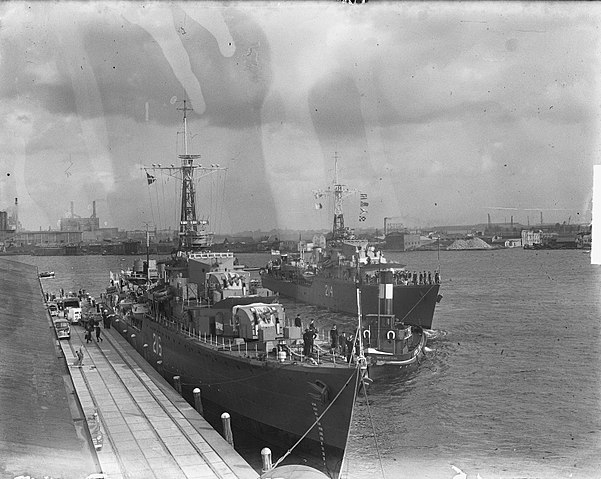
HMCS Huron and Micmac in Amsterdam in the 1950s. The Dutch CV Karel Doorman often participated in Canadian’s hunter-killer ASW groups between the North Atlantic and European waters.
Articles, done and upcoming
- Annapolis class destroyers (1963)
- Canadian Tribals (Iroquois class) (1941)
- Halifax class Frigate (1988)
- HMCS Bonaventure (1957)
- Iroquois class helicopter destroyer (1970)
- Mackenzie class destroyer (1961)
- Restigouche class destroyers (1954)
- Saint Laurent class Destroyers (1951)
- Upholder class submarines (1986)
- Algonquin class/Type 15 frigates (1952)
- River (mod) 1955
- Tribal class FFs (Project)
- Ojibwa class sub. (1964)
- Kingston class MCFV (1995)
The RCN in postwar years
As observed in Conway’s, after some transfers in 1947, when the cold war started, the RCN was the “most sophisticated of the British commonwealth navies”. The main additions started right away, and in March 1946, the most interesting of these, HMCS Warrior. A Colossus class Carrier, transferred after completion. She served only two years, returned in the UK in 1948, as HMCS Magnificent was transferred instead. She was returned in turn, HMCS Magnificent took its place and served until 1971. The cruisers stayed in service until 1960-61, and the Tribal-class built in Canada and a few others served until 1964-69. 23 River class Frigates served until the 1960s while most of the 28 Bangor class, 10 St Marie class minesweepers were sold in the 1950s, up to 1961.
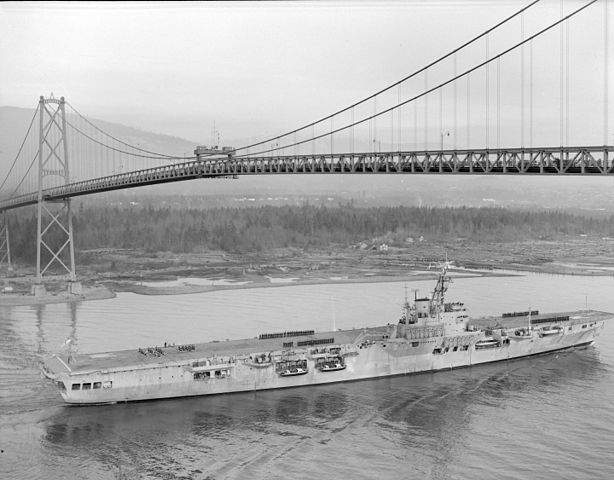
H.M.C.S. Warrior passing under the Lion’s Gate Bridge
Canada started also with a solid naval industry, having delivered a large number of destroyers, frigates and other vessels for its naval service. There was a solid structure structure in place, battle-proven to manage ships, crews, maintenance and supply. Post-war economy however curtailed most of this force to concentrate on the essential assets to perform its mission. Both cruisers were expensive to maintain and non-essential, and they were discarded, as well as the sole carrier ten years later. In addition during most of her service, HMCS Bonaventure operated mostly as an helicopter carrier, in ASW role. A transition started, as the RCAN started to produce its own design, still with some RN influence, but US electronics, before going into fully domestic designs.
In 1945 as the needs of the RCN in the Atlantic progressed, the Canadian government agreed to acquire two British carriers on loan, with an option to purchase them. This was planned by the admiralty however, none were ready before the war ended. In the context of acute postwar budget restrictions, this meant Canada could only afford to operate one carrier, and no two as planned initially. So this was HMCS Warrior, replaced by the slightly larger HMCS Magnificent.
The RCN in the Korean War
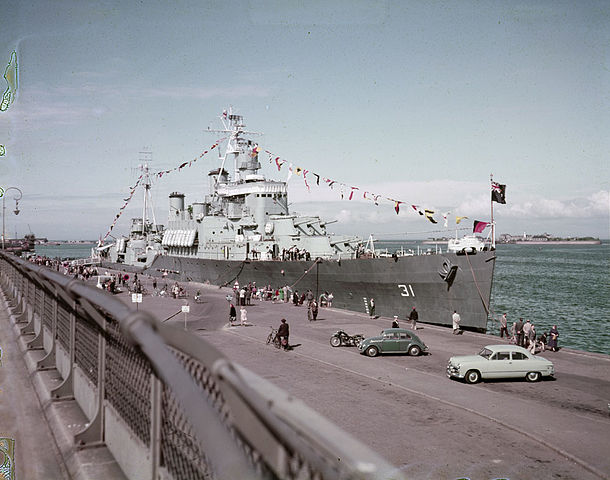
HMCS Quebec at Stockholm in 1954, during the Korean War.
From 1950 to 1955, during and after the Korean War, Canadian destroyers maintained a presence off the Korean peninsula, engaging in shore bombardments and maritime interdiction.
The Suez crisis
In November 1956, the aircraft carrier HMCS Magnificent transported men and supplies to Egypt, Canada’s contribution to the RN during the ill-fated Suez Crisis. In preparation for this she saw her armament removed and own complement reduced to 600 personnel. HMCS Magnificent waited in Halifax until the end of November to load, then sailed for Egypt with 406 Canadian troops on board and vehicles as well as four RCAN de Havilland Canada DHC-3 Otter placed plus an H04S helicopter. She unloaded her cargo and made it back home by March 1957.
The RCN in NATO: the ASW command
The Canadian Navy, part due to the strategic location, part due to her inheritance from WW2 was soon entrusted in the alliance as the main ASW component of North Atlantic. Its anti-submarine capability was specialized and dedicated entirely into the search and destruction of a Soviet naval submarine threat which was increasing, notably with the mass-production of the Whiskey class. In 1957, the RCN sacrificed HMCS Magnificent in exchanged for HMCS Bonaventure, more modern, larger and modernized to carry jet aircraft. The RCNAF took delivery first of the McDonnell F2H Banshee fighter jet, in service until until 1962 and piston-engine ASW aircraft and helicopters until her decommission. In mid-1960s, RCN’s WW2 ASW massive fleet of frigates and corvettes was gradually retired and the country developed its own designs for anti-submarine warfare. These rugged vessels, well suited to the unforgiving and icy cold north Atlantic deployed the large Sikorsky CH-124 Sea King, a local version of the famous helicopter, pioneering the use of large maritime helicopters on small vessels.
These were the St Laurent, Restigouche, Mackenzie, and Annapolis class “destroyers” buit on a the same basic model with variations. All of the above were basically sub-classes of a single type of “destroyer”, which was hardly one based on usual western standard, more a denomination. By their tonnage indeed they were 2000 tonnes vessels. Missile destroyers of the time were more on the 3500 tonnes range. The first 18 vessels were pure ASW destroyers without even an helipad, which were added in various refits. The serie started in 1955 and ended in 1964 with the DDE 265 Annapolis class which were the first dedicated helicopter destroyers, much smaller compared to their Japanese equivalents. The Annapolis reached 3000 tonnes deeply loaded, versus 6300 tonnes for a Haruna class in 1971. Typical armament for these 20 vessels were 3in/5 guns for self-defense, Mk32 ASW torpedo launchers, and the Limbo ASW mortar system.
The great reforms of 1968
From 1964 through 1968, under the Liberal government of Lester B. Pearson, the Royal Canadian Navy, Royal Canadian Air Force and Canadian Army were amalgamated to form the unified Canadian Forces. This process overseen by then–Defence Minister Paul Hellyer was a very controversial merger which completely eliminated the Royal Canadian Navy as a separate legal entity. Personnel, ships, naval aviation and based were all placed under an UCF division called the Maritime Command (MARCOM), Canadian Armed Forces. The naval uniform was replaced by the standard new Canadian Armed Forces rifle green uniform also used by the RCAF. Although naval aviation was still under command of MARCOM, the latter also gained use of shore-based patrol aircraft of the former RCAN. In 1975 the Air Command was formed, and all naval aviation was to be transferred to the Air Command’s Maritime Air Group (ACMAG). This unification was almost universally despised by the military in their respective branches, as destroying any sense of identity and traditions; but was the fist time worlwide such a radical approach for the military was made. It made a lot of sense on a political level however as well from the taxpayer point of view, with massive cost savings due to the reduction of management personel, ordnance and supply. This was compounded by drastic policy changes also for MARCOM, with Minister of National Defence Donald S. Macdonald in 1971 to sovereignty protection rather than being ASW-focused.
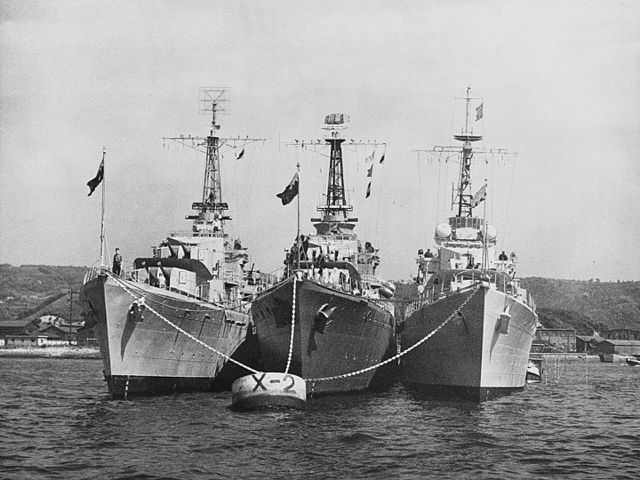
HMCS Nootka alongside HMAS Warramunga and HMS Cockade at anchor in 1951.
FOCUS: Bras d’Or
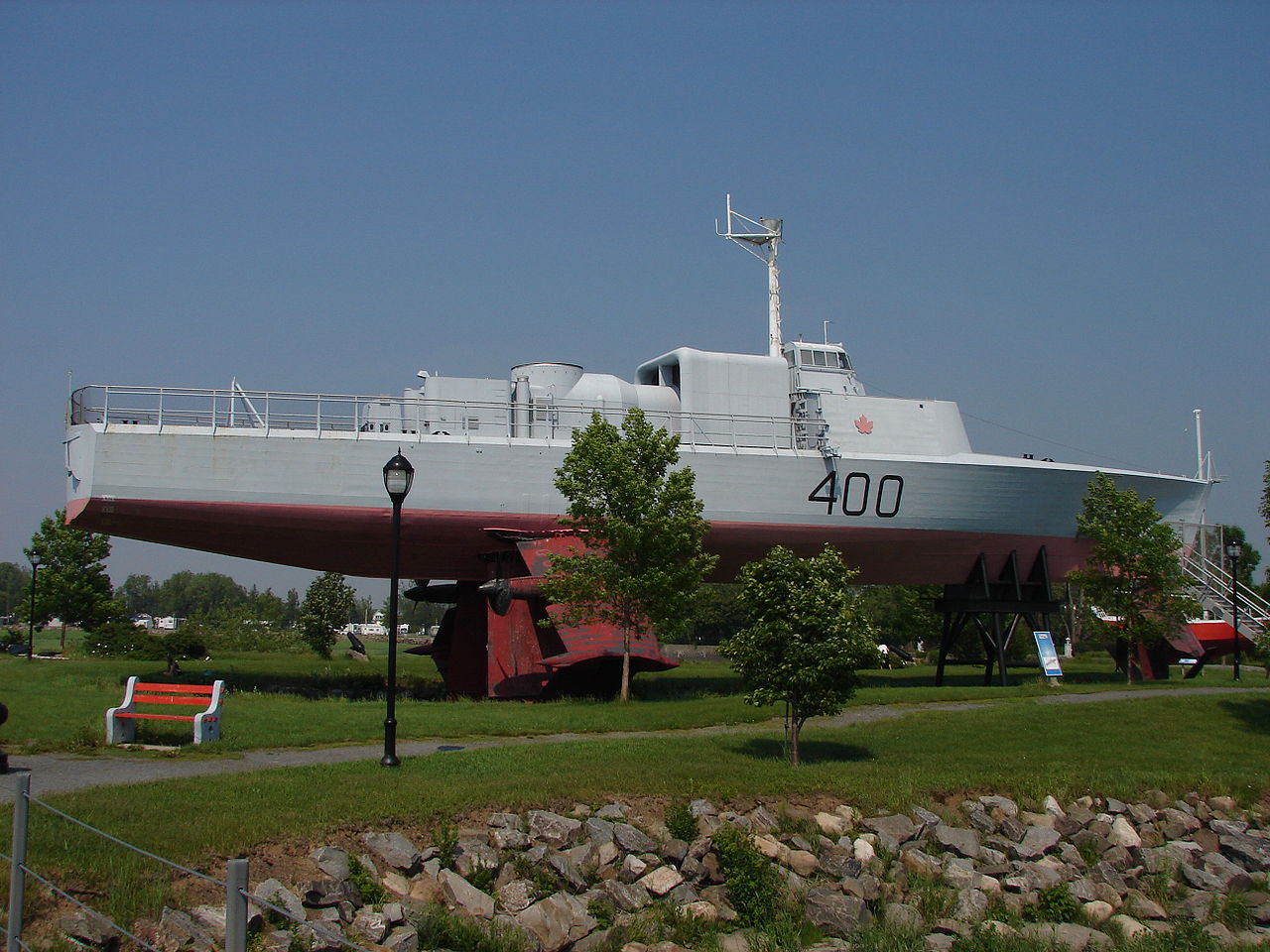
Bras d’or, hydrofoil FAC FHE 400 (1968): She was arguably the best Canadian FAC (Fast Attack Craft) designed during the cold war and the fastest warship ever built when commissioned in 1968, capable of 63 knots. Built at Marine Industries Limited, Sorel-Tracy, Quebec, and its genesis went back to WW2 and a British-Canadian research group which created the Saunders-Roe R-103, a prototype hydrofoil which tested many foils configurations and prepared many design features later found in the Bras D’Or. The name of the ship is referring to the Lake on Nova Scotia’s Cape Breton Island, where inventor Alexander Graham Bell performed hydrofoil experiments in the early 20th century near his estate and new laboratory at Beinn Bhreagh as well as the historic site of the first flight of an aircraft in Canada also under the patronage of Bell.
Commander Donald Clark, CD, RCN, initiated the project, built by de Havilland Canada for its aluminium expertise. Bras d’Or was entirely in this material to save weight, but with maraging steel for its foil system, coated in neoprene. The latter used a canard configuration and were of course foldable. This required two propulsion systems/ In hullborne operation, a Paxman Ventura 16YJCM sixteen-cylinder diesel engine folded to a pair of variable-pitch propellers. In foilborne mode, a single FT4A-2 gas turbine developing 25,500 horsepower (19.0 MW)/21,500 rpm coupled to General Electric gearboxes driving two three-bladed supercavitating propellers. There was even a third powerplant, a Garrett GTCP85-291 gas turbine for all electrical systems, notably when the FAC was stopped and anchor or as emergency power. The idea was the vessel cruised on diesel until it reached the radar detection zone of the enemy vessel, and then passed onto foil mode for attack. It was hope her great speed and profile would not help the defenders to hit her on her way to deliver her armament, either antiship missiles or torpedoes.
No armament was ever fitted on the hydrofoil, which would remained experimental, making tests campaigns to demonstrate the concept, starting9 April 1969 near Chebucto Head. She was very stable in heavy weather even at 40 knots, which was remarkable in itself, exceeded 63 knots (117 km/h; 72 mph) on trials, setting a world record, only approached recently by the Norwegian Skjold-class corvettes (60 knots, fully equipped). The program was abruptly cancelled on 2 November 1971 by Minister of National Defence Donald S. Macdonald, and definitely terminated by the liberal Pierre Elliott Trudeau later. Here, Bras d’Or is preserved at the Musée maritime du Québec, L’Islet-sur-Mer, East Canada.
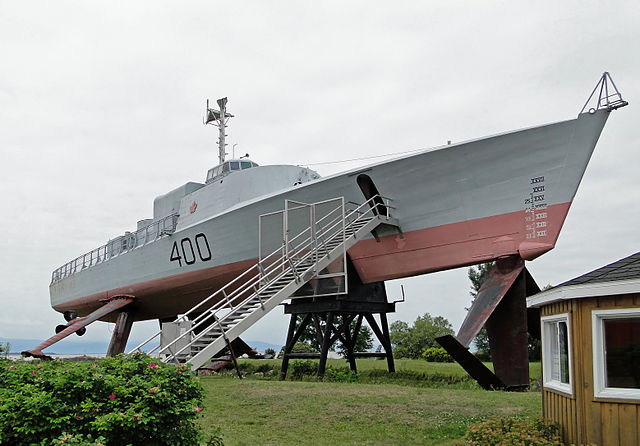
1971 saw indeed massive budget cuts and policy changes, notably terminating the traditional ASW warfare focus within NATO: Canada’s only carrier, HMCS Bonaventure was sold off in 1970, just after undergoing a 16-month, $11 million mid-life refit. Alongside it, most remaining WW-2 era ASW Frigates were sold for scrap. However the 1970’s also sa a new generation of versatile vessels introduced, such as the four large Iroquois-class destroyers, later updated to air defence destroyers. The movement was followed in the 1980s and 1990s by the construction of twelve Halifax-class frigates, purchase of the Victoria-class submarines and started in 1987 the massive City class Helicopter Frigates program undergoing until 1997.
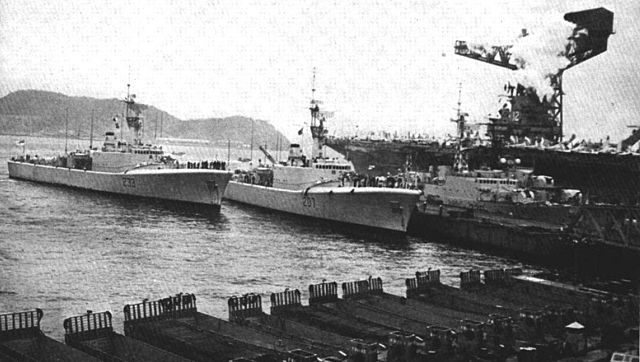
St Laurent class destroyers visiting the U.S. Naval Base Yokosuka, Japan in 1958. These three ships were HMCS Fraser (DDE 233), HMCS Skeena (DDE 207), HMCS Crescent (DDE 226), close to HMCS Cayuga (DDE 218), of the modernized Canadian Tribal class. USS Hornet (CVA-12) is moored behind, assigned Air Task Group 4 (ATG-4). Circa 1958.
In 1985, MARCOM’s personal were granted new specific black uniforms, and in 1990, the three senior naval officers recreated the Naval Board. By that time, Canada sent a task force in Persian Gulf as part of the Coalition forces. Three ships in support of Operation Desert Shield and Operation Desert Storm. In 1990 also, Canada deployed three warships to support Operation Friction. Later the RCAN was deployed to patrol the Adriatic Sea during the Yugoslav Wars and the Kosovo War. Today, since the 2000s, the Maritime Command procured vessels to be part of Operation Apollo to combat piracy off the coast of Somalia and protect passage of the massive traffic passing through the red sea and coming from Asia.
Meanwhile, on 16 August 2011, the government restored the historic names of the Canadian Forces, and the Navy was called “Royal Canadian Navy” again. From August 2015, the RCN was amputated from services such as air defense and resupply capabilities, classified as a Rank 5 navy meaning an offshore regional coastal defense navy, based on the Todd-Lindberg classification system. In 2005 the RCN was still a Rank 3 (multiregional power projection) navy.
The RCN today: Strength and structure
The Royal Canadian Navy is headquartered at National Defence Headquarters (NDHQ) in Ottawa, Ontario. Since 2012 it has been charged with coordinating and maintaining forces of the Canadian Joint Operations Command.
Maritime Forces Atlantic
It is base din CFB Halifax, the headquarters for the Atlantic command, Royal Canadian Navy.
The Atlantic Flee (“Canadian Fleet Atlantic”) is joint with the Maritime Forces Atlantic (MARLANT) headquartered in Halifax (Nova Scotia), supported by CFS St. John’s (Newfoundland). The Royal Canadian Air Force’s 12 Wing in Shearwater Heliport is organically attached to it. It is providing shipborne air support for the Atlantic Fleet. RCAF’s 14 Wing Greenwood is the fixed-wing air support, comprising the 404 Maritime Patrol/Training Sqn and the 405 Maritime Patrol Squadron. CFAD Bedford is also part of this command, with an ammunition depot, as well as two radio stations, Naval Radio Section (NRS) Newport Corner and NRS Mill Cove. The Atlantic Fleet comprised 18 warships and many more auxiliary vessels. It covers Canada’s EEZ on the East Coast, but also its area of responsibility within NATO in the Atlantic/eastern Arctic.
Maritime Forces Pacific
It is based at CFB Esquimalt (British Columbia), headquarters for RCN units, Maritime Forces Pacific (MFP). Known as Canadian Fleet Pacific, it is co-located with Maritime Forces Pacific (MARPAC) also in the same base in the Greater Victoria region. MARPAC had over 4,000 naval personnel assisted by 2,000 civilians. This fleet Comprises 15 warships and auxiliary vessels in Esquimalt NB. The Pacific Fleetwtached over Canadian EEZ in the northern Pacific West Coast and western Arctic Ocean. There is a Fleet Maintenance Facility at Cape Breton and an air arm, the Royal Canadian Air Force’s 443 Maritime Helicopter Squadron (Patricia Bay Heliport) dependent of 12 Wing Shearwater command. This is for hipborne helicopter support. Also the 19 Wing Comox for fixed-wing maritime patrol and air support, MARPAC: 407 Long Range Patrol Squadron. There is also an ammunition depot at CFAD Rocky Point, and Naval Radio Section in Aldergrove.
This is the Primary Reserve component of the RCN, force generate sailors and teams for CAF operations, either for domestic safety, security or defence. It is also supporting PR efforts with the Canadian public through a broad national presence.
Naval Tactical Operations Group
The NTOG comprised about 85-100 personnel, full-time and reserve sailors conducting boarding missions on non-compliant vessels and training associated. This includes some spec-ops skills, like precision/sniper shooting, hand-to-hand combat and interrogation techniques but also advanced medical skills, as well as identification and disposal of IEDs.
Naval Security Team: This is a modular naval team mostly composed of naval reservists which could be deployed for various missions, providing enhanced force protection (FP) and security on RCN ships and protect its personnel at home or overseas. It was deployed for the first time in 2017 for HMCS Winnipeg during her visit to Busan.
Read More/Src
veterans.gc.ca royal-canadian-navy
warmuseum.ca battle-of-the-atlantic-1939-1945
Royal Canadian Navy Commissioned ships
navy-marine.forces.gc.ca
thecanadianencyclopedia.ca
Conway’s All the World’s Fighting Ships 1947–1995
//en.wikipedia.org/wiki/Royal_Canadian_Navy
G.N. Tucker, The Naval Service of Canada, Volume II, Ottawa, King’s Printer, 1952.
wikipedia.org/wiki/List_of_ships_of_the_Royal_Canadian_Navy
wikipedia.org/wiki/History_of_the_Royal_Canadian_Navy
www.canada.ca/en/navy/services/history/ships-histories/prestonian.html
www.canada.ca/en/navy/services/history/ships-histories.html
https://www.navypedia.org/ships/canada/can_dd.htm
The 1950-1970 fleet
Canadian Aircraft Carriers
HMCS Warrior (1941-48)
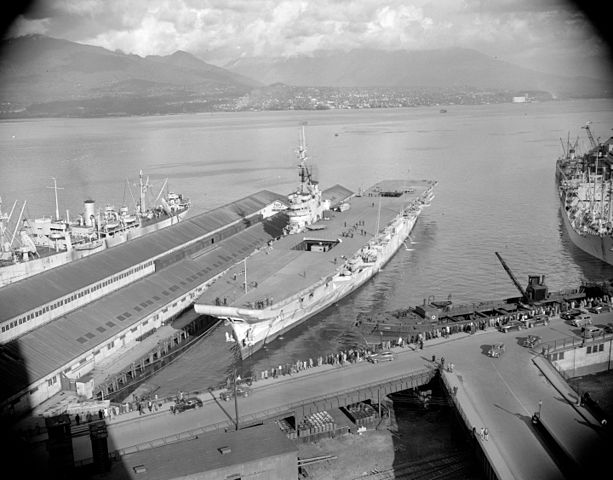
HMCS Warrior at Vancouver.
Planning to acquire a CV started in May 1944 for Royal Canadian Navy (RCN) participation in the final campaign in the pacific in 1945. The escort carriers on loan HMS Puncher and Nabob were returned in exchange for two of the larger new light fleet carriers. By July 1945 negotiations were finalised and Warrior and Magnificent were granted with a purchase option. Negotiations completed in May also for the transfer of a dedicated naval air squadron however but the war ended.
Later, four squadrons were transferred from the Fleet Air Arm nevertheless to serve from HMS Warrior, 803, 883 Squadron (Supermarine Seafires) and 825, 826 Squadron (Fairey Fireflys) and when HMS Warrior was completed, it was transferred to the RCN, commissioned as HMCS Warrior on 24 January 1946. First captain was Frank Houghton. The carrier entered Halifax harbour on 31 March 1946 escorted by HMCS Micmac and a minesweepe, joining the Canadian Atlantic Fleet on 23 March 1946. After her shakedown cruises and fixes she started operations in the summer, but in August, she lost a Firefly from 825 Squadron in operations. She later ran aground at Pointe Sainte Antoine, near Montreal as her rudder apparently jammed. She was towed off and resumed her trip to Montreal.
The RCN soon had issues wirth the unheated equipment used in the North Atlantic winter waters and she was transferred to Esquimalt in British Columbia by November 1946. From there, she toured south, visiting Bermuda, Acapulco, Mexico and San Diego in California by December 1946. Under Commodore Harry DeWolf and after repairs she lost another plane in oprations, while the government realized it could ill-afford to maintain two carriers due to post-war constraints. Negotiations to return HCSM Warrior started as HMS Magnificent was ready for transfer. In February 1947, she returned to Halifax with HMCS Uganda and Crescent, stopped in California, passed the Panama Canal and visited Cuba. After a trip back to Halifax she returned to Bermuda with Nootka in an exercise with the Royal Navy. According to Conways in August 1947 she sailed for the United Kingdom, taking onboard Firefly Mark IV and Hawker Sea Fury before returning home. In November 1947 she sailed with HMCS Haida to Bermuda and prepared to be paid off. She sailed to UK on 12 February 1948, stopping at Belfast and Spithead and recommissioned as HMS Warrior on 23 March 1948 in Portsmouth, tow days after her decommission.
HMCS Magnificient (1948-57)
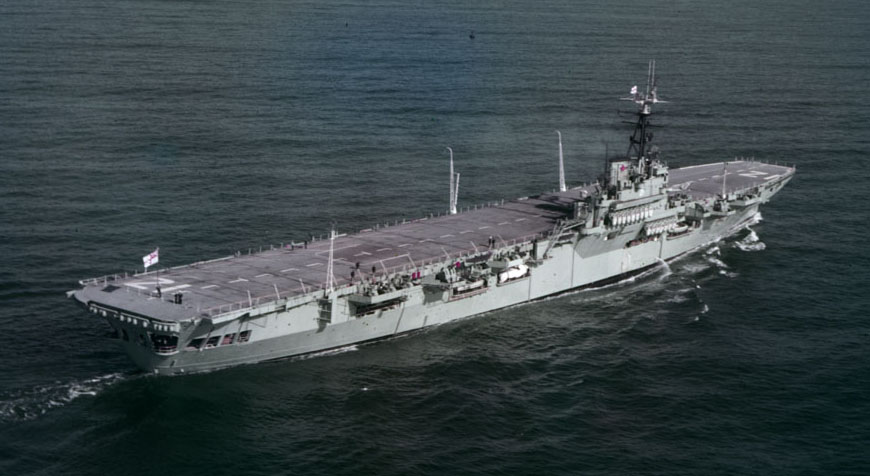
HMCS Magnificient underway in 1954
After operating the HMCS Warrior of the Colossus class and being critical of its lack of heating systems for the cold in 1946, she was transferred to the Canadian Pacific Fleet and returned after she she was decommissioned in 1947. At the same time, HMS Magnificent was completing and all preparations were included to be capable of operating in cold climates in the Atlantic. She was commissioned into the RCN on 21 March 1948, while Warrior was decommissioned two days later and went on her career in RN service. She served ten years before being sold to Argentina, as ARA Independencia. On her side, HMCS Magnificient arrived in Halifax on 1 June 1948, and performed workups in which she lost two aircraft. She operated the Hudson Strait with the destroyers Nootka and Haida, starting a training cruise to the Ungava peninsula (Quebec) and Wakeham Bay. She became later the first RCN warships to penetrate Hudson Bay. In 1949 she sailed to the UK, embarking new Firefly Mark Vs for her 825 Squadron. She went home and carried 803, 883 and 826 Squadrons in a training cruise to the Caribbean Sea but on 20 March 1949, 22 aircraft handlers refused an order of morning cleaning stations, protesting for various grievances. Meawnhile similar ‘incidents’ happened on Crescent at Nanjing in China, on Athabaskan off Mexico and captains acted wisely each time to difuse crisis.
In June 1949, HMCS Magnificient went aground off Port Mouton in Nova Scotia. Towed off by HMCS Maggie she was repaired in Saint John. In December 1951 she started a refit lasting, until March 1952 and in September took part in a large NATO Exercise, Mainbrace. Contrary to popular opinion she never participated in the operations in Korea, arguing her commitment to NATO missions in the North Atlantic. In 1953 this was exercize Mariner. She took part in Coronation of Queen Elizabeth II’s fleet review. In March 1954, she underwent a refit at Portsmouth and the next year she sailed to the Caribbean Sea for training with the US and Royal Navy. She then toured the UK with Micmac and Haida and back home. By September she made another European cruise and participated in two NATO naval exercises. She operated helicopters from her deck and on 10 October there was the last flight of one of her TBF Avenger before being retired. These were models tailored for ASW warfare.
By November 1956, she was sent to the United Nations Emergency Force when the Canadian goverment backed the British Government on the Suez crisis and agreed to send ground forces to Egypt. HMCS Magnificent was prepared to transport men and supplies, her weapons were stripped, complement reduced to 600 but she never embarked the Queen’s Own Rifles of Canada, as the order was rescinded in December. She waited in Halifax and embarked 406 Canadian troops and vehicles and 4 De Havilland Canada DHC-3 Otters plus a H04S helicopter fore sailing for Egypt, arriving off Port Said in early January 1957. She then covered the presence of Canadian peacekeeping force in Egypt and returned to Canada in March 1957. She left Canada in April 1957 for Plymouth, decommissioning on 14 June, replaced by HMCS Bonaventure, also a Majestic-class carrier completed after the war. She was unable to operate modern jet aircraft, urging her replacement. She was broken up at Faslane, Scotland, in July 1965.
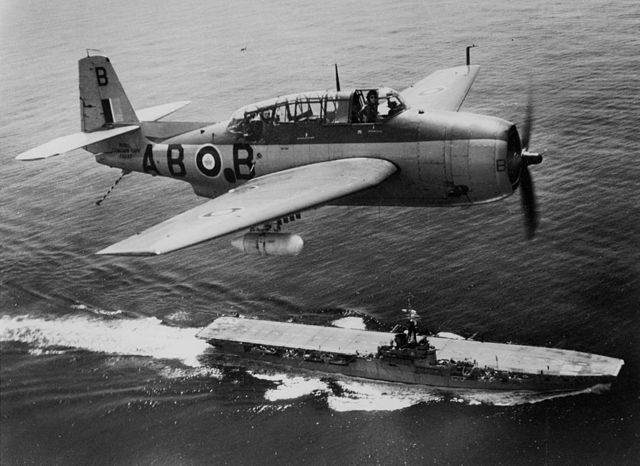
TBM-3 above HMCS Magnificient. Specs of HMCS Magnificient as the same as other Majestic class fleet carriers, but with tailored heating equipments for Canadian service.
HMCS Bonaventure (1957-71)
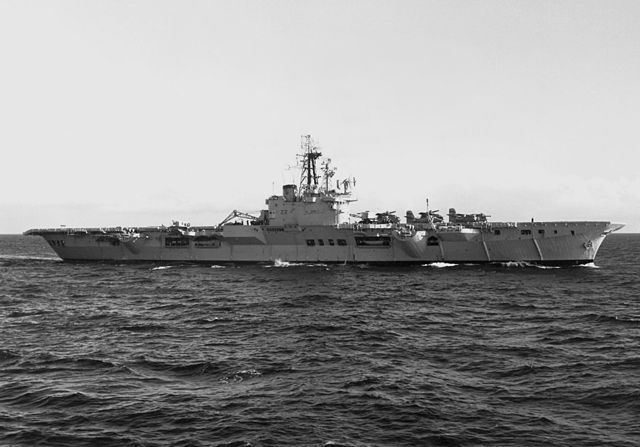
CVL-22 as named in the RCN nomenclature and HMCS Bonaventure (named after one of the oldest cities in Quebec) started as HMS Powerful, part of the second batch of the Colossus class in WW2, but construction was halted in 1945, and her hull laid up. She was purchased by the RCN in 1952, her hull sent for completion to Harland & Wolff NyD of Belfast, on a tailored modernized design, part of the post-war Majestic subclass. For specs see the Majestic class. She could reach 24.5 knots and a crew of 1,370 officers and ratings less the aviation crew. HMCS Bonaventure was one of the very last light fleet carrier and had a distinct tall lattice mast, raked funnel, and large sponson for the 3-inch guns plus a modified deck plan. The mast also carried the latest USN radar, SPS-8A height finder and the SPS-12 air search radar. Her complement of aircraft was to include jets for the first time also due to heir reinforced and widened angled flying deck and new powerful catapults and optical landing system.
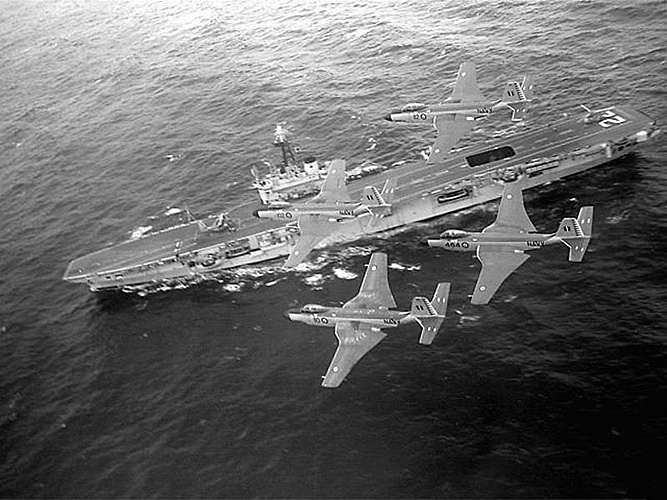
McDonnell Douglas Banshee flying over HMCS Bonaventure. These were the first and last jet fighters deployed by the RCAN, retired in 1962.
Tailored for heavier aircraft, up to 20,000 pounds (9,100 kg), landing at 87 knots (161 km/h; 100 mph) she was modified to even carry larger ones, up to 24,000 pounds (11,000 kg). Her lifts were enlarged to 54 by 34 feet (16 m × 10 m) also. She had a greater landing area allowing aircraft parking asn the old crash barriers. She carried five squadrons, at first a complement of sixteen McDonnell F2H Banshee jet fighters (VF 870 and VF 871), and eight Grumman CS2F Tracker ASW aircraft (VS 880, VS 881) plus a few Sikorsky HO4S ASW helicopters. Trackers were only fully operational from 1959. HMCS Bonaventure conducted sustained around-the-clock operations for NATO over 200 square nautical miles (690 km2) during her first missions. Her HO4Ss helicopters had a dipping sonar and Mark 43 torpedoes and soon proved a serious proposition against the best Soviet subs of the day. Banshees were retired in 1962 and never replaced. So, the carrier became a pure ASW vessel, increasing her helicopter park to 18 HO4Ss. In 1963, she was refitted to operate the heavier Sikorsky CHSS-2 Sea King, carrying the same number.
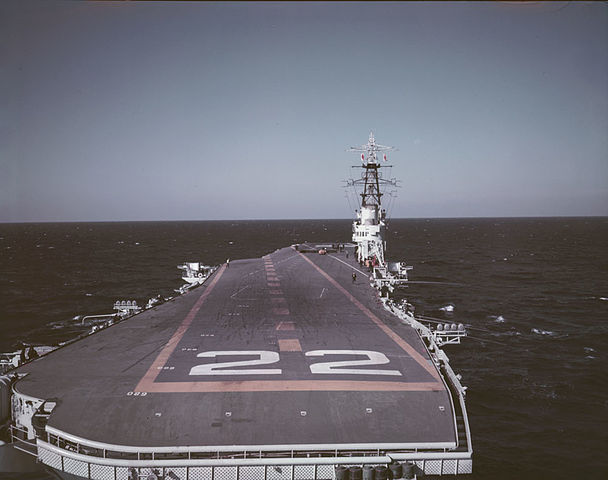
HMCS Bonaventure’s flight deck
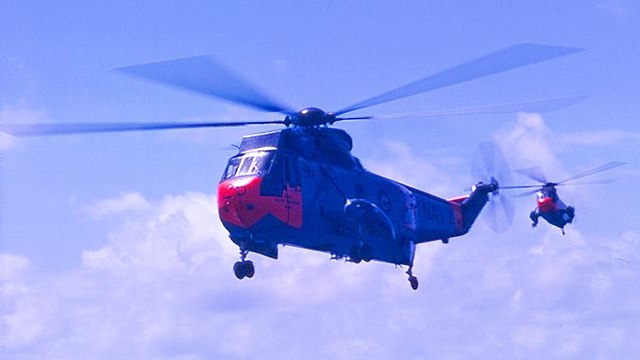
CVL-22’s Sea King Helicopters in 1968. She operated forteen of them.
The carrier made numerous missions in 1957-58 with NATO and in November that year, while operating off the Grand Banks of Newfoundland, she made contact with a Soviet Navy submarine close to a group of Russian fishing trawlers, which nearly triggered a diplomatic incident, although the latter was in international waters. In 1960 NATO focused her North Atlantic defense around the ASW hunter-killer group led by Bonaventure. On 13 October 1962, she witnessed but did not took part in the Cuban Missile Crisis blockade flotilla. Later she participated in realistic exercizes on ASW defences in the Greenland-Iceland gap followed by cross-deck operations with the aircraft carrier HNLMS Karel Doorman. In 1963-64 participated in exercise Gooey Duck in Bermuda, served in the Mediterranean, participated in United Nations peacekeeping Operation Snow Goose,carrying troops to Cyprus. In 1955 her air group ws specialized more and she participated in UK to a Joint Anti-Submarine School at Londonderry, operations in the Southwest Approaches with HMS Ark Royal and HNLMS Karel Doorman. In 1966 she underwent a major refit in order to extend her service life. She was misly affected by the 1968 Unification of the Canadian Forces, resuming her missions at first, particopated last in 1970 to Exercise Maple Spring and she was decommissioned at Halifax on 3 July 1970, no longer relevant in the eyse of the government which wanted to stop the ASW-first policy of the Navy, and also for budget cuts.
Specs, as tailored for Canadian service in 1957
-Displacement: 16,000 T standard, 20,000 tonnes FL
-Dimensions: 214.6 x 39 x 7.6 m (704 x 128 x 25 fts)
-Powerplant: 2 shafts geared steam turbines, 4 admiralty boilers
Performances: Output 40,000 shp for 24.5 knots (45.4 km/h) and oil 3200 tons
-Armament: 4×2 3in/50, 4x 3pdr saluting, 21-24 aircraft
-Electronics: Radars: SPS-8A, SPS-12
-Crew: 1370
Canadian cruisers
HMCS Uganda(later HMCS Quebec) served in 1943-1961 and HMCS Ontario from 1946 to 1960. They differed little for the British ships, Crow Colony class for the first and Switsure class for the second. However both were “winterized” for Canadian service, with added insulation and steam heating for the weaponry and electronics as well as all deck fixtures, plus USN pattern search radar.
HMCS Quebec (Ex-Uganda)
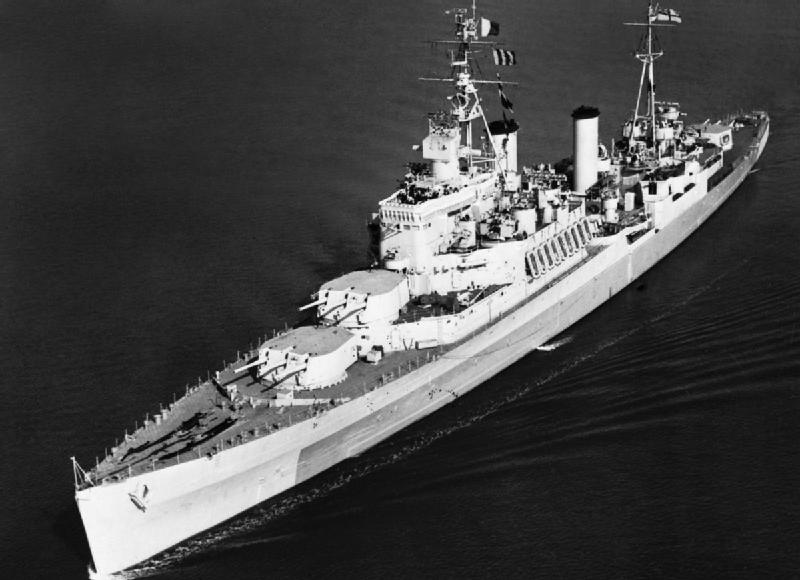
HMCS Uganda underway. HMCS Uganda remained unaltered for most of her active life. In 1960 she was one of the last conventional cruisers. She was renamed Quebec in 1952 and alterned training duties as a schoolship and escort missions for the Canadian aicraft carrier task force and ASW hunter-killer group. She spent her later years in Halifax as a school ship.
Her return to active duty from her inactivation in 1947 dated from her entry into the Korean War, and commitment of units of all branches to the British Commonwealth Forces in Korea. This necessitated her reactivation starting in August 1951, she was refitted and modernized at Esquimalt and recommissioned on 14 January 1952, as HMCS Quebec (C31). She sailed to Halifax, visited Quebec on 14 June 1952 and in 13–25 September, accompanied HMCS Magnificent in the major NATO naval exercise Mainbrace in northern European waters. By February 1953, she sailed to Bermuda for training and in June became flagship for Rear Admiral Bidwell in Spithead (coronation of Queen Elizabeth II). In October 1954, she made a seven-week training cruise to the Caribbean Sea and South America. By mid-April 1955, she circumnavigated Africa. She was paid off on 13 June 1956, placed in reserve at Sydney, Nova Scotia and was sold in 1960 for scrap, which took place in Japan in 1961.
HMCS Ontario
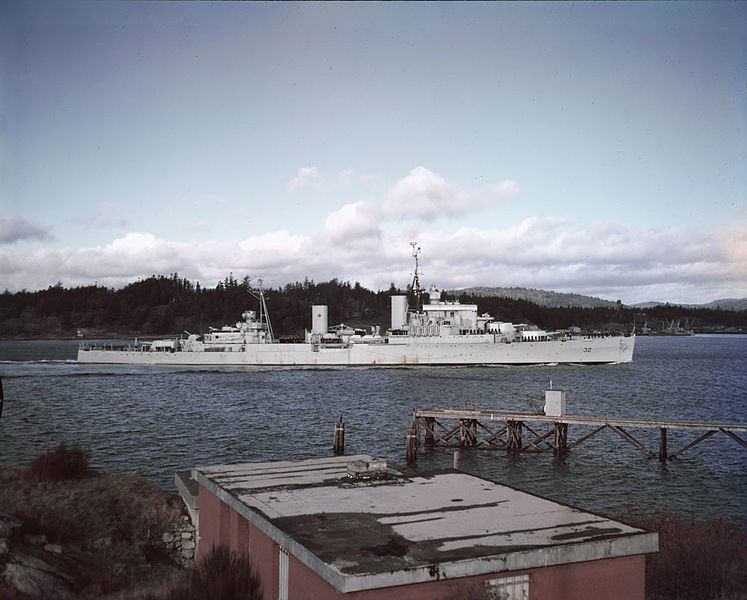
HMCS Ontario in the 1950s
HMCS Ontario on her side was of the more modern and larger Swisftsure class, completed just before the war ended. She entered service with the RCN in May 1945. Intended to serve for the final missions in the pacific, she toured Hong Kong, Manila and Japan in 1946. In October 1948, she sailed with the destroyers Cayuga, Athabaskan, Crescent and the frigate Antigonish to Pearl Harbor and in January 1949, took part in the largest training cruise so far for the RCN with Magnificent, Haida, Athabaskan and the frigate Antigonish (CTF 215), taking part in naval exercises with US and RN ships in the Caribbean Sea. In February 1951, she sailed to Australia for exercises with the Royal Australian Navy. In October that year, she toured the east coast and hosted the Duke of Edinburgh in a Royal Visit. Throughout 1952, sailed around South America suffering in Buenos aires a minor collision with the merchant vessel SS Arauco. And in Rio de Janeiro her starboard propellers was found damaged and was partially repaired in situ. She returned to Esquimalt for full repairs. By June 1953 she took part in the Coronation Fleet Review and in January 1954, started a training cruise across the Pacific, and after returning home, a three-month training cruise to Australia and New Zealand. In early 1955 she started a four-month cruise of Europe and the rest if the year visited North and South America. She was paid off on 15 October 1958, and sold with Quebec to Mitsui and Co. of Japan to be BU from November 1960. Her bell has been preserved, currently held at HMCS Ontario Cadet Training Centre in Kingston, Ontario.
Canadian Destroyers
The Royal Canadian Navy inherited from WW2 a sizeable fleet of eleven destroyers. Some were Canadian-built, seven in all of the famous “tribal” class, most completed shortly after the end of the war in 1945-46. They were all modernized. Others, of the ‘Cr’ and ‘Valentine’ class were transferred postwar. They were mostly used for escort missions of the Canadian aircraft carriers as part of ASW groups, and were modernized, sometimes radically, such as the two vessels converted to Type 15 Frigates. They served until the 1960s, in anticipation of the 1968 reforms, no longer relevant in the new context.
Iroquois (‘Tribal’) class (1941)
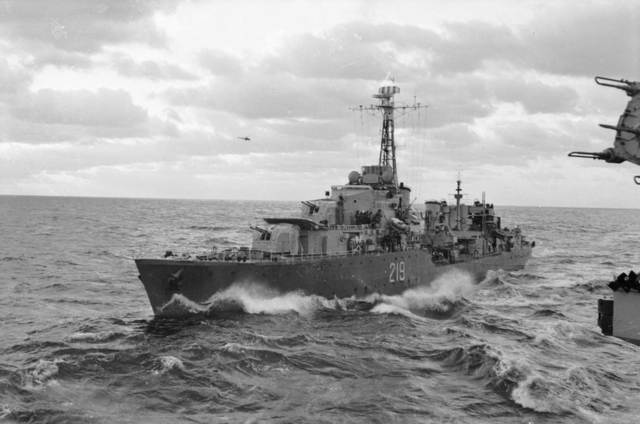
The “Tribals” were arguably the most powerful destroyer class built by the British during WW2, and they were also the best Canadian and Australian destroyers, built by local yards. Their main advantage was a powerful artillery in twin turrets, eight in all, to the expanse of a torpedo tubes bank. Canadian yards delivered eight vessels during the war, some completed in 1946: HMCS Haida, Cayuga, Huron, Micmac, Iroquois, Nootka and Athabaskan (ii), all bing named of Canadian Indian tribes. The 1st one, HMCS Athabaskan first of the name was sunk in action in 1944. Haida was one of the most active during the war and still preserved today. They formed the bedrock of classic surface warfare escort for the two Canadian cruisers in service and aircraft carriers in the 1950-60s, but were of course duly modernized to stay relevant in the 1960s.
Nootka, Micmac, Cayuga and Athabaskan were indeed even still fitting out when the war ended and saw service at the beginning of the cold war, incorporating many changes resulting from wartime lessons: Nootka and Micmac retained their 4.7 in guns but omitted their DCTs. They had 40 mm Pompom mounts aft instead and twin Mark V for Nootka on either side. Athabaskan had four twin 4-in /45 Mk 16 and a Mark 6 director and twin 40 mm Mk.V AA. Piecemeal modernization were staged in 1946 up to 1951. 4.7 in guns were replaced by 4-in, USN pattern Mk63 radars FCS, and Squid SW mortars on their quartedeck while all light AA was replaced by 40 mm AA Bofors.
In 1951 ful modernization began for the whole Haida class: It was staged in steps between 1952 and 1955 when the last was recommissioned. This was aimed at making them more ASW-capable according to the NATTO policy of the time. It concerned the armament and fire control. Two Twin 4-in/45 Mark 16 UK pattern installed forward, a single twin 3-in/50 Mk22 aft on “X” position, four individual 40 mm/60 Boffins AA guns, and two Squid mortars on the quarterdeck. Short aluminium lattice fitted, new caps for funnels, Mark 6 or Mark 63 directors upgraded and stripped Mark III(W) director fitted for surface fire. They had also fiberglass shields for their 3-in guns (Cayuga and Athabaskan). As such, these vessels served the RCAN 1964-1969.
Specifications after 1955 refit:
-Displacement: 2200, 2500 tonnes FL
-Dimensions, Powerplant, Performances: same as ww2 Tribal class
-Armament: 2×2 4in/45, twin 3-in/50, 4x 40mm AA, quad 21-in TT, Squid ASWMR
-Electronics: Radar 275, SPS-10, SPS-6, 293, 262, Sonar 170, 174.
-Crew: 240
Cr/Valentine class (1943)
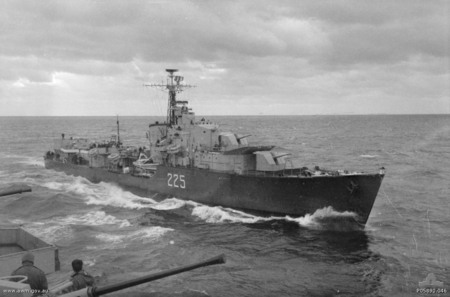
HMCS Sioux in the 190s.
These ‘V’ and ‘Cr’ class British-built destroyers of 1943 were transferred in 1945 and comprised the Crescent and Crusader, Algonquin and Sioux, reclassed as destroyers escorts in 1952, but only two were given a Type 15 conversion refit for ASW warfare: Algonquin and Crescent, similar to the British Type 15 Frigates. Sioux and Crusader however had their ASW systems upgraded. For details about hethe Type 15 frigate conversion, see the cold war Royal Navy page.
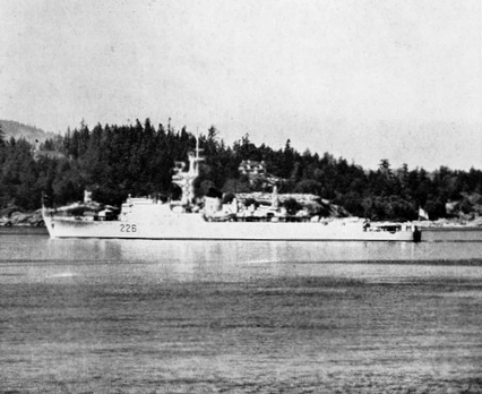
HMCS Crescent in 1958
Canadian Frigates
In the 1960s, Canada still operated twenty-three ASW Friagtes of the wartime “River” class (The Loch class vessels were retired unmodified earlier). These 2,180 tonnes vessels were modernized for a part in the 1950s. These were the: HMCS New Glasgow, La Hulloise, New Waterford, Outremont, Lanark, Lauzon, St. Catherine’s, Penetang, Swansea, Prestonian, Antigonish, Ste Therese, Beacon Hill, Stettler, Buckingham, Stonetown, Cap de la Madeleine, Sussexvale, Port Erie, Toronto, Incharran, Victoriaville, Jonquiere.
They differed at the base from RN River class by their twin 4in Mk 16 AA placed in ‘B’ position. HMCS Prestonian was the first modernized, in 1951-53. Her forecastle was lengthened and widened, right aft, funnel raised, as well as a larger and higher bridge. Machinery was removed and replaced by two steam engines and diesel generators with greater output, and a modern sonar, more powerful, installed. After sea trials and first exercizes it was concluded this was a very successful conversion. Other frigates soon followed suite, modernized until 1958 except HMCS St catherine and Stonetown, which were converted as weather ships. It would be too long to detail their career, the class will be the object of a dedicated post.

HMCS Stonetown 1963 as a weather ship
Specifications after the 1955-58 refit:
-Displacement: 1570, 2360 tonnes FL
-Dimensions: 91.8 x 11.2 x 4.9m (310 x 36 x 16 ft)
-Powerplant: 2 shafts VTE, 2 admiralty 3-drum boilers, 2 diesel units
-Performances: 5500 ihp, 20 knots, oil 720 tonnes
-Armament: 1×2 4in Mk16, 6x 40mm AA (Mk5, Mk9) 2 Squid ASWMR
-Electronics: SQS-2, TDY-1, ECM gear
-Crew: 140
The Cold war RCN
In this chapter are detailed the “new navy”, with ships tailored to local needsand built in Canadian yards, which were Esquimalt DyD, Canadian Vickers, Halifax SyD, Burrard, vancouver, Marine Ind, Sorel, Davie SB lauzon (later MIL Davie), victoria Machinery and St John SB for more recent ships like the City class Frigates laid down from 1987. The smaller yard Port Arthur built the Gaspe class minesweepers (With Canadian Yarrow and other yards).
Destroyers & Frigates
Algonquin class destroyer escorts (1952)
These two vessels, Algonquin and Crescent were not precisely “brand new” vessels: They were in fact converted destroyers from WW2, former HMS Crescent and the ex-Valenine, ex-Kempenfelt (HMCS Algonquin). The ASW focus of the RCN made it relevant to rebuot them as dedicated ASW Frigates along the lines of the existing British Royal Navy Type 15 conversion, which allowed many former WW2 destroyers to become relevant in the new context of the cold war and the threat of mass-built Soviet submarines roaming the Atlantic. This was however the Canadian version of the type 15 Conversion, following the same general lines but with a larger, taller bridge to fend off heay weather waves of the North Atlantic, and all-American electronics. Algonquin had a RN-pattern twin 4-in aft and US pattern 3-in/50 forward. Crescent was different in having her twin 4-in forward and the 3-in aft, so reversed. Both also had the new 40 mm Boffin abreast of the funel and Crescent a prominent cap over her funnel. Conversion work started at Esquimalt DyD (which was not equipped to built complete vessels), starting in 1952 and completed in 1956. Both ships subsequently added ten years to their active service compared to other Canadian destroyers of the era. The ASW focus being no longer relevant at that time.
Specifications:
As British Type 15 conversions.
St Laurent class destroyer escorts (1951)
St Laurent, Saguenay, Skeena, Ottawa, Margaree, Fraser, Assiniboine
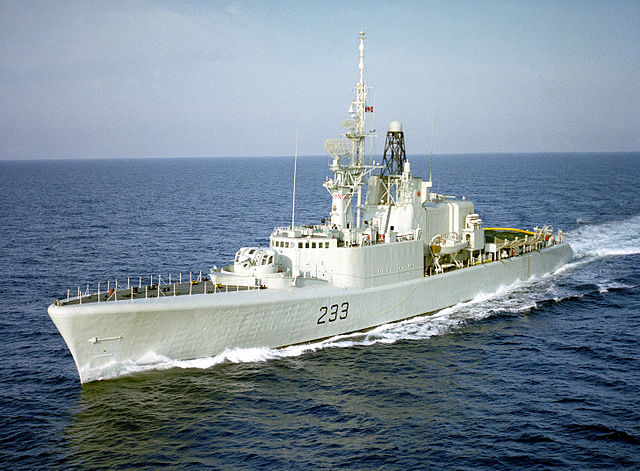
HMCS Fraser of the St Laurent class underway in 1983. She was disposed of in 1994.
The later 1940 pressing need for ASW escorts of NATO urged efforts of all kind, either conversions (see above) which were the cheapest, fastest way to achieve this objective, of building new dedicated ships, in a difficult context financially. This was helped by massive funds. The Canadian Government voted the construction of a serie of domestic destroyer escort to be built over ten years. In total, the class started by St Laurent would comprise tenty vessels from 1950 when the first keel was laid down, to December 1964 when the last was completed, with a different design. general outlines and specifications were generally the same, with differences as we will see.
The British proposed their Whitby class vessels, but the USN nothing which matched exactly the needs of the RCN. Therefore, it was decided to create a purely domestic design. To achieve this, the government asked a Montreal naval architect, German & Milne for proposals in 1948. The design was refined and developed under the supervision of Rowland baker, senior director of naval consrtuction for the RCN and the final design was made ready in late 1949, with some additions until the blueprints were delivered in early 1950. Baker used the Withby as a model, with the same machinery, imported from the UK at that point, but US electronics, and electrical gear Canadian. Baker was British and virtually remake the Type 12 design, but with an original external design to make it looks more “Canadian” and manage local susceptibilities. But the vessels really were Withby-class in disguise.
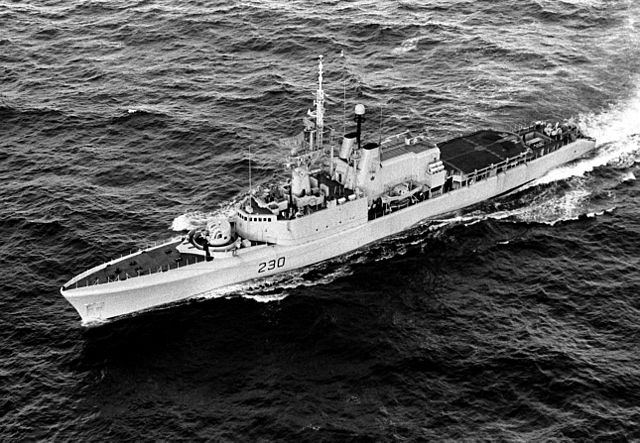
Margaree after her 1960s refit, showing her helicopter pad. She was retired in 1994.
The St Laurent, Saguenay, Skeena, Ottawa, Margaree, Fraser, Assiniboine were laid down between November 1950 at Canadian Vickers (the first and only one) and May 1952 in Sorel, completed between 1955 and 1957. In 1961 already came their first modernization campaign. They were all equipped with a VDS (variable depht sonar) at the stern, while their Limbo Mk 10 ASW mortar was removed and two 40 mm AA guns to make room for a hangar and helicopter pad installed on the former quartedeck. Both were sized to house large helicopters and indeed, when the last conversion was completed in 1966, all could carry a Sikorsky Sea King built in Canada (CHSS-2), greatly improving their ASW range and capabilities. From then on, they were rated as helicopter carrier destroyers or DDH and their numeration changed accordingly. Then two years later, the great narmed branches reforms came and their ASW focus was no longer supported. So beginning in 1972, St Laurent was laid up, but not sold and discarded before 1979 and the others in the 1990s. Assiniboine was a training ship from 1989 in Halifax.
The St Laurent was seen as a success and followed by near-sisters, the improved Restigouche and Mackenzie class.

Specifications:
-Displacement: 2000 t standard, 2600 t FL
-Dimensions: 113.1 x 12.8 x 4.2 m (371 x 42 x 13 ft)
-Powerplant: 2 shafts English Electric steam turbines, 2 Babcock & Wilcow boilers
-Performances: 30,000 shp and 28 knots.
-Armament: 2×2 3-in/50 DP, 2x Boffins 40 mm AA, 2 Limbo ASWM Mk.10
-Electronics: Radar SPS-12, 12, SPG-48, Sonar SQS-501/502/503/504, VDS (1966)
-Crew: 290
Restigouche class destroyers (1954)
Restigouche, Chaudière, Gatineau, St. Croix, Kootenay, Terra Nova, Columbia
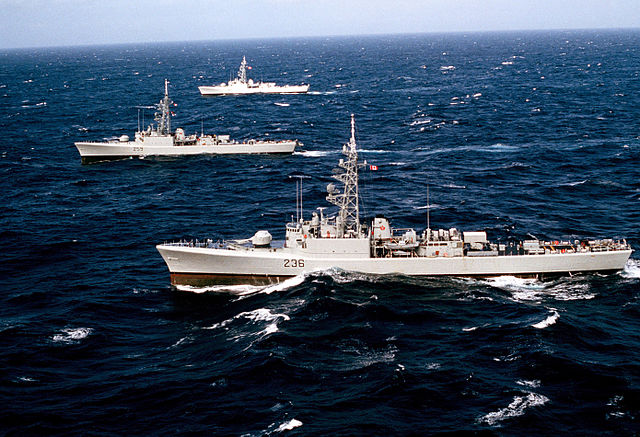
Restigouche class DDEs in Alaskan waters
Ordered in 1952 as a repeat of the St. Laurent class, they integrated the new British twin 3in/70 Mark 6 forward, not ready when the previous class was built, and and US-pattern 3-in Mk22 aft. Four of the class, Restigouche, Gatineau, Kootenay and Terra Nova were modernized, but not in the same line as the St Laurent, between 1966 and 1973. A VDS was installed, and ASROC launcher aft replaced one of the two Limbo mortars, and US-pattern aft 3-in twin turret. They had no helicopter pads or facility. A new lattice foremast stepped was also installed, and from 1974, St Croix, Chaudières and Columbia joined the reserve, the first reduced to harbour service and the others were still active in the 1990s. The last retired were HMCS Kootenay (DDE 258) sunk as an artificial reef off Mexico in 2001, and Gatineau (DDE 236) scrapped in pictou shipyard in 1998.
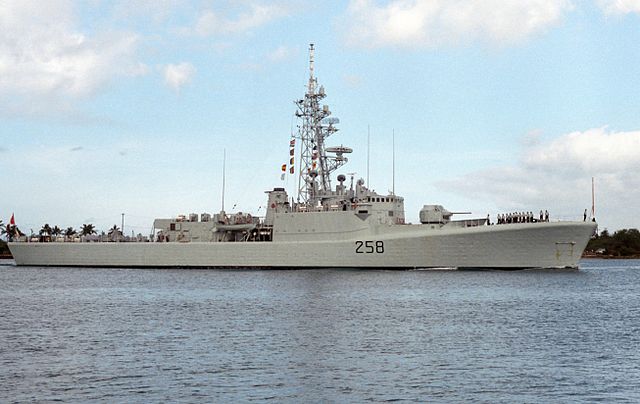
HMCS Kootenay in Pearl harbor
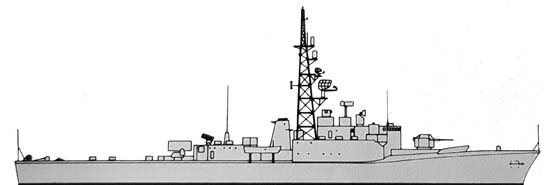
Specifications:
-Armament: 2×2 3-in/70 Mk6 DP, 2x 3-in/50 Mk 22 DP, 2 Limbo Mk10 ASWM, 2x 40 mm Boffins
-Electronics: SPS-12, SPS-10, Speey Mk2, SPG-48, SQS-501, SQS-203, VDS (1970s)
Mackenzie class destroyers (1961)
Mackenzie, Saskatchewan, Yukon, Qu’Appelle
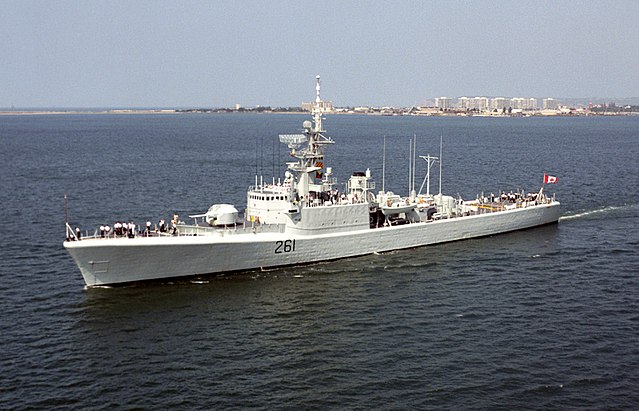
HMCS Mackenzie off San Diego in 1992
These were basically “repeat restigouche” with few changes but improved habitability, better pre-wetting, bridge, weatherdeck fittings and features to deal with extreme cold. Only difference in armament was a pair of triple Mk32 12.75 in ASW torpedo launchers on the broadsid. On HMCS Yukon and Qu’Apelle, the forward British 3-in twin mount was eplaced by an US one. They were completed in 1962-63 and during the DELEX refits at Esquimalt in 1982-85, they were given an SQS-505 sonar and new navigation radar. In 1992, they started to be replaced by the new “City” class frigates.
Annapolis class Helicopter destroyers (1963)
Annapolis, Nipigon
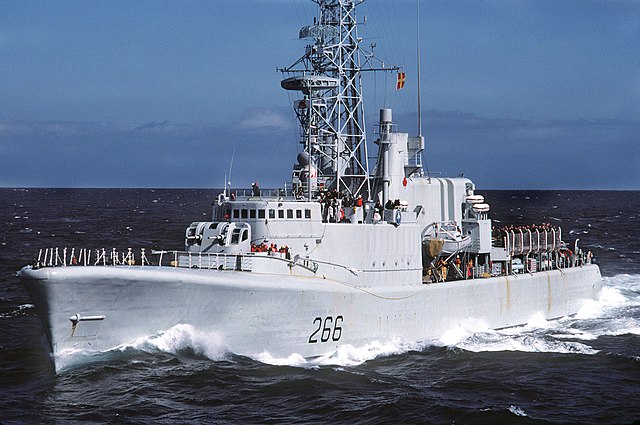
The final development of the St Laurent class DDs. Ordered in 1959 to incorporate all the developments made on previous ships as modernized, they were completed with a hangar and helideck aft, operating a Sea King. Displacement reached 3000 tonnes fully loaded and because of the topwight, they carried only the USN pattern 3-in/50 Mk33 forward and the SQS-501 VDS. In 1977-79 they were modernized s DDH, and in the 1980s under the DELEX program and in 1987-88 they gained the SQR-501 CANTASS towed sonar for trials and evaluation. Completed in 1964, they were both still extant in the 1990s, paid off 1996-98 and BU 2003-2015, scuttled off-shore to create artificial reefs.

Specifications: As Restigouche class
Tribal class missile frigates (cancelled, 1963)

These were eight large general-purpose Frigates announced in 1960, which would have been named as the seven destroyers they replaced. However the program was cancelled in 1963 before any order placed. The development served in the new Iroquois program (see later). Specs were like the latter with few exceptions. The most interesting part of the design was their RIM Tartar naval air missile, making them the first Canadian missile frigates ever designed. The new Iroquois were more conventional helicopter destroyers.
Specifications:
-Powerplant: 2-shafts geared steam turbines
-Performances: 36,000 shp, 30 knots
-Armament: 1x 5-in/54 Mk42, Tartar RM-24 SAM, 2×3 324 mm ASW TTs.
Canadian Submarines
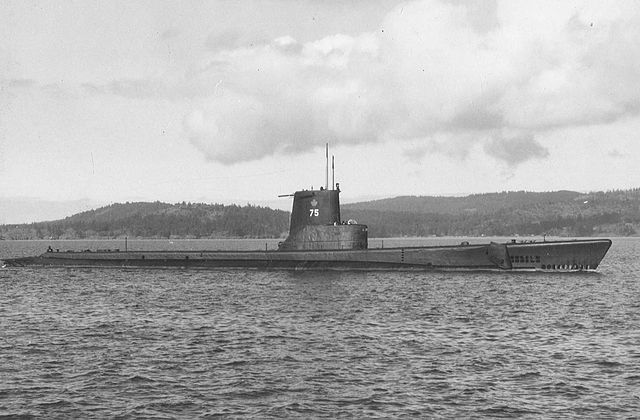
Being focused on searching and killing submarines, Canada never really developed any use for submarines, it did not fit NATO’s requirement nor national ones. Nevertheless, as submarines can be useful hunter-killers of their own against Soviet submarines, the RCN operated five submarines during the early cold war, and for training. There is no plan to built or purchase new ones.
Transfers: Grilse, Rainbow (1961-68)
HMCS Grisle was the first Canadian submarine, the ex-USS Burrfish SSR312, of the modernized Balao class. She was an ex-radar picket conversion of the 1950s, acquired in 1961. She was initially on loan by the RCN for two years, extended to five later, kept for ASW training at Eskimalt. She was formally commissioned on 11 May 1961 and in May 1966 the loan was extended until 1969 shen she was returned to the USN.
HMCS Rainbow was the ex- USS Argonaut SS 475, a classic “fleet snorkel” conversion acquired to replace Grisle in December 1968. She served in the same purposed at Eskimalt SB and was returned to the USA on 31 December 1974 to be scrapped.
Ojibwa class submarines (1964)
HMCS Ojibwa, Onandaga, Okananga
The only “serious” class of submarines deployed by Canada. These were British-built, at Chatham, on the Oberon class SSK design. They were identical to the British models, but with some differences: They were armed with the Mk 37C ASW torpedoes, and carried 22 of them, as pure submarine hunter-killers. Laid down in September 1962, June 1964 and March 1965, they were completed in 1965-68. HMCS Ojibwa started her upgraded (SOUP for Submarine Operational Upgrade Program) in 1920, followed by her sister-ships in 1983 and 1982-86. As completed, they had a completely new sonar arrangement with the Marconi Type 2051 Triton and enlarged bow dome, new fire control system Singer-Librascope Mark I Mod 0, better passive array andn active transducers in a reworked fin while the type 2007 was retained. In 1987 the FCS and launching systems were revised again to handle the Mk48 Mod 4 torpedo and sub-harpoon, which radically enhanced her SSM capabilities. HMCS Onondaga left the Atlantic for the Pacific in 1994 but they were decommissioned in 1998 and one preserved as a museum ship.
Misc. vessels
HMCS Sackville, minelayer (1956)
As the name indicates. This was a “flower” class corvette retained in post-war service, laid up in 1953-56 to be converted as a minelayer, AN 113. She was design to lay “loops” of controlled minefields, lent to the naval research lab for oceanographic work, redesignated AGOR 113 in 1964 and specialized in survey work.
Specifications as rebuilt:
-Displacement: 1084/1350 tonnes FL
-Dimensions: 62.5 x 10.1 x 4 m (205 x 33 x 14 ft)
-Powerplant: 1 shaft VTE; 2 boilers, 2750 hp
-Performances: 16.5 knots, Oil 230 tonnes
-Armament: None
-Crew: 38
HMCS Bluethroat, loop layer (1955)
Before the Sackville was converted, a first loop minelayer was built, HMCS Bluethroat, started in 1951, completed in 1955, redesignated AGOR 114 in 1954 and converted for survey duties. She was sold in 1991 to a US private company.
Specifications as rebuilt:
-Displacement: 785/870 tonnes FL
-Dimensions:47.8 x 10 x 3 m (205 x 33 x 14 ft)
-Powerplant: 2 shaft diesels 1200 hp
-Performances: 13 knots, Oil ? tonnes
-Armament: None
-Crew: 25
Gaspé class coastal minesweepers (1951)
Gaspé, Chaleur, Fundy, Comox, Cowichan, Ungava, Quinte, Miramichi, Fortune, James Bay, Thunder, Resolute, Chigneto, Trinity, Fundy (ii), Thunder (ii), Cowichan (ii), Chaleur (ii).
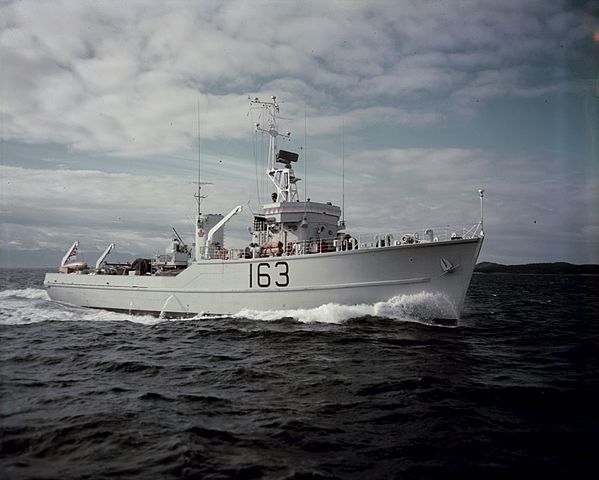
HMCS Miramichi
Four coastal minesweepers were ordered in 1950, called AMC/MCB. Ten more followed in 1951. They were built locally, between Favie SB, Port Arthur, St John, Victoria Machinery, Canadian Yarrow, Kingston SYd, and Marine Industries, numbered MCB-143 (HMCS Gaspé) to 164 (HMCS Chaleur), twenty in all. They were based on a proven design; The “Bay” class coastal minesweepers based on a WW2 model, but more particularly on the British ‘Ton’ class. To avoid problem with magnetic mines, they were built in degaussed aliminium for the framing and wood, for the planking. In 1954, sox were resold to France (see the cold war french section). In 1958, four wre sold to Turkey. In 1972 their designation was changed again for small patrol escorts of FFL and in 1979 they were used for training with PB pennant numbers.
Specifications:
-Displacement: 390/412 tonnes FL
-Dimensions: 46.3 x 8.5 x 2.6 m (152 x 28 x 8 ft)
-Powerplant: 2 shaft GM 12 cyl diesels 2400 hp
-Performances: 15 knots, Oil 52 tonnes
-Armament: 40 mm/60 Mk.7
-Crew: 40
Bird class sub-hunters (1955)
Class: Loon, Cormorant, Bleu Heron, Mallard
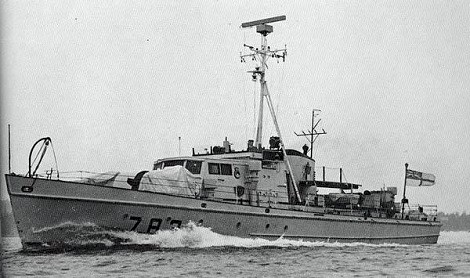
HMCS Mallard (PCS-783), SRC
These vessels were built from 1955 in wood and aluminium as submarine chasers, harbour patrol and ASW training. They were all paid off in 1963 while HMCS Blue Heron was transferred to the Marine section of the RCMP (Royal Canadian Mounted Police) and served for many more years. Arctic Tern (PCS 784), Sandpiper (PCS 785), Herring Gull (PCS 786) and Kingfisher (PCS 787) were planned but never built.
Specifications:
-Displacement: 66 tonnes FL
-Dimensions: 30.2 x 5.6 x 1.7m (92 x 17 x 5ft)
-Powerplant: 2 shaft diesel 1200 bhp, 14 knots
-Armament: 20 mm AA, Hedgehog and DCs
-Crew: 21
The 1970-90s fleet, reformed RCN
Iroquois class helicopter destroyers (1970)
Iroquois, Huron, Athabaskan, Algonquin.
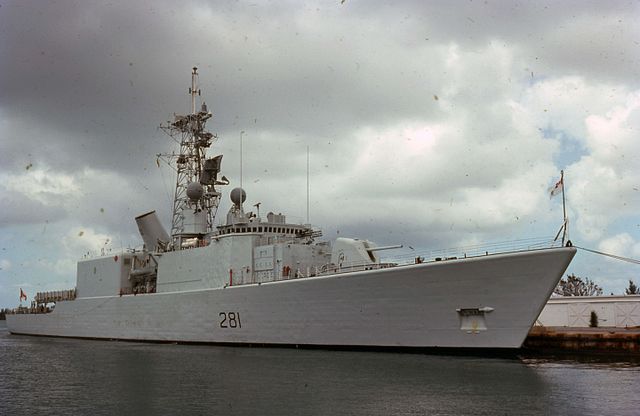
HMCS Huron in 1976
The new “Tribals” were a less amphitious program than the cancelled previous missile frigates (see above) by the new government. They constituted however a step-up in terms of size and capabilities compared to the St Laurent class, being twice as large with a deep load of 5100 tonnes when modernized. They were named DDH and later DDG, helicopter-carrying, guided missile destroyers, which they became under the TRUMP modernization program in the 1980s. Basically these “tribals” were ordered in 1968 based on the past development, same hull as the cancelled GPF of 1960, but a rather conventional armament, however two hangar to carry heavy duty helicopters, a force multiplier. When completed in 1972-73 they were saluted by the international naval press as ones of the most powerful escort ships in the world. Their large hull was tailored to present a massive superstructure followed by two hangars either side of the exhaust funnel, lattice mast, wide helideck and lower aft deck with a VDS. They jad a forward Italian OTO Melara 5-in guns forward and ASWRL mounted forward of the main bridge. Contrary to previous designs, they adopted an Italian rapid fire gun and Dutch radars.
In 1986, funs were allocated to carry out the long-awaited AAW program the Canadian Navy wanted, performed under the name of TRUMP (‘TRribal’ class update and modernization program) by Litton Systems Canada Ltd. They adopted US missile systems and guiding radars. The Standard SM-2 adopted was way better than the Tartar previously envisioned, and antimissile capabilities enhanced by the adoption of Phalanx guns. The forward section was modified to house the Standard SAM silo launcher and the 5-in was replaced by a much smaller 76 mm OTO Melara ‘super rapido’ gun in B position. The Phalanx CIWS were installed aft on the hangar roof. The funnel exhaust and powerplant were modified as well with a GM Allison cruising turbine, and all the electronics on board. the latter included decoy launchers, ESM and ECM. Algonquin was modernized at MIL-davie (Lauzon, Quebec) in 1987-91, Iroquois in 1988, and he last two emerged from the program in 1993, so after the end of the cold war. From 1986 they were re-rated DDG-280 to 283.
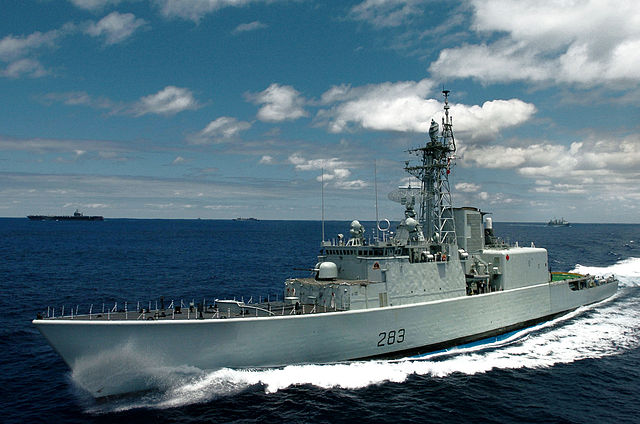
HMCS Iroquois in the 1990s as modernized.

HMCS Huron as completed
Specifications (1973):
-Displacement: 3,351 t standard, 4,700 t DL
-Dimensions: 128.9 m oa (121.3 pp) x 15.2 x 4.4 m (433 x 50 x 14 fts)
-Powerplant: 2 shafts CODOG, 2 Pratt & Whitney FT4A2 gas turbines, 2 cruising turbines
-Performances: 50,000 shp, and 7400 for the P&W FT12AH3 gas turbines, 29 knots
-Armament: 1x 5-in/54 OTO DP, 320 mm ASWRL, 2×3 324 mm ASW TTs, 2 Sea King helicopters
-Electronics: LW-08, STIR 1.8, SQS-501, SQS-505
-Crew: 23 officers 232 ratings, +30 air crew

HMCS Iroquois after TRUMP
Specifications (Modernized):
-Displacement: 5,100 t DL
-Powerplant: Same but GM Allison 570 KF cruising gas turbines
-Armament: 1x 3-in/70 OTO SR, M41 Standard 2 SAM, Mk 15 Phalanx CIWS, 2×3 324 mm ASW TTs, 2 Sea King helicopters
-Electronics: LW-08, STIR 1.8, SQS-505, shield DL, SQL-504 Canews,ESM, ILQ-6 ECM
“City” class helicopter frigates (1988)
Halifax, Vancouver, Ville de Quebec, Toronto, Regina, Calgary, Montreal, Frederickton, Winnipeg, Charlottetown, St John’s, Ottawa.
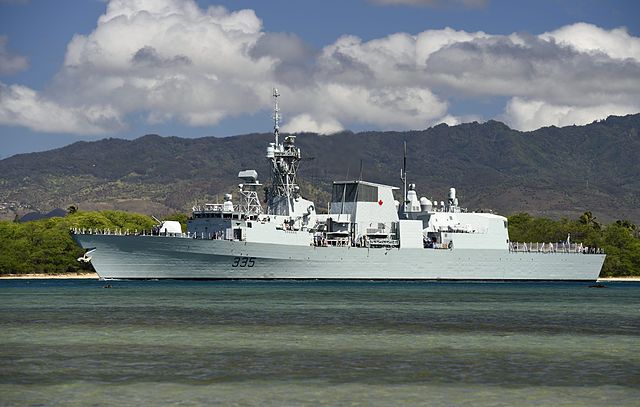
HMS Calgary leaving Pearl Harbor in 2014
This was at first an ambitious program of twenty vessels, but the order for the first six ships was delayed until 22 December 1977, years after the until planning. In addition, the contract was not awarded to the St John Shipbuilding Co. of New Brunswick before June 1983 and construction started in March 1987. Planned for the cold war, none of these ships would see it and their general conception was already outdated. Nevertheless, for multipurpose helicopter Frigates, they were a balanced design, with the advantage of costs reduction due to the large production at the same yardd, St John. The only exception was MIL-Davie of Lauzon for Ville de Quebec, Regina and Calgary. The twetny vessels figure was never aproached, instead 12 vessels were completed until 1998, numbered HFF-330 to 341, also called “Halifax class Frigates”.
Design wise they shared their hull with the previous Iroquois class, a few meters longer and larger, with a longer quarterdeck aft, extending to over the stern’s VDS with a large helideck and large hangar for a single Sea King helicopter, or Merlin EH-101, and today a CH-148 Cyclone helicopter. Armament was rather comprehensive, and of US origin, notably with a SAM and SSM capabilities with Harpoon launchers. A single super-fast 57 mm gun forward provides an all around artillery capability, antimissile protection is ensured by two CIWS units, decoys and chaff, ECM/ESM.
As of today, Canada planned replacement is the “Canadian Surface Combatant”. This is quite an ambitious vessel, part of the new class of “super frigates” of 7000-8000 tonnes of displacement, basically destroyers in disguise. The program is aiming at replacing the former Tribal and City class ships by 15 new modular vessels, beginning in the mid to late 2020s, as part of the National Shipbuilding Procurement Strategy.

City class Specifications:
-Displacement: 3600 tonnes standard, 4750-4770 tonnes FL
-Dimensions: 134.1 oa(124.1 pp) x 16.4 x 4.9 m (440 x 54 x 16 ft))
-Powerplant: 2 shafts CODOG GE LM 2500 Gas Turbines SEMT Pielstick 20PA-V280 diesel
-Performances: 46,000 shp + 8800 bhp, 28 knots, range 7100 nm/15 knots
-Armament: 1x 57 mm/7 SAK Mk2, 8 Harpoon SSM, 2 Mk48 Sea Sparrow SAM, Mk15 Phalanx CIXWS, 2×2 324 mm ASW TT, 8x 05 cal.HMG, 1Helicopter
-Electronics: SPS-49(V)4n Sea Giraffe HC 150, Sonar SQS-505(V)6, SQR-501 CANTASS
-Crew: 225
Kingston class maritime coastal defence vessels (1995)
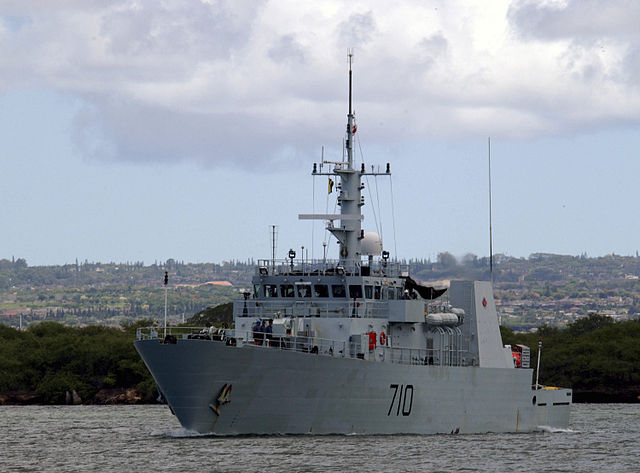
These ships are just mentioned her, as already off-topic: They were started in 1995, but ordered in 1991 and studies started in 1988. All were built at Halifax SY. Small patrol vessels of 962 tonnes, they have a 40 mm/60 Mk 5C Boffin and two 12.7 mm HMG. Originally they were planned as mine countermeasure vessels, with limited peacetime patrol and training role, and theur MCM wacability was drastically reduced to lower cost. The last of the class, HMCS Summerside (MM 711) was completed in 1999. Replacement is not expected before 2030.
Specifications:
-Displacement: 962 tonnes
-Dimensions: 55.3 x 11.3 x 3.4 m (181 x 37 x 11 ft)
-Powerplant: 2 shafts Wärtsilä diesel-electric
-Performances: 3000 bhp, 15 knots, range 4000 nm at 12 knots.
-Armament: 40 mm/60 Mark V Boffin AA, 12.7 mm (.5 cal.) Browning M2HB HMG
-Electronics: Radar KH1006, Towed Sonar sidescan
-Crew: 17

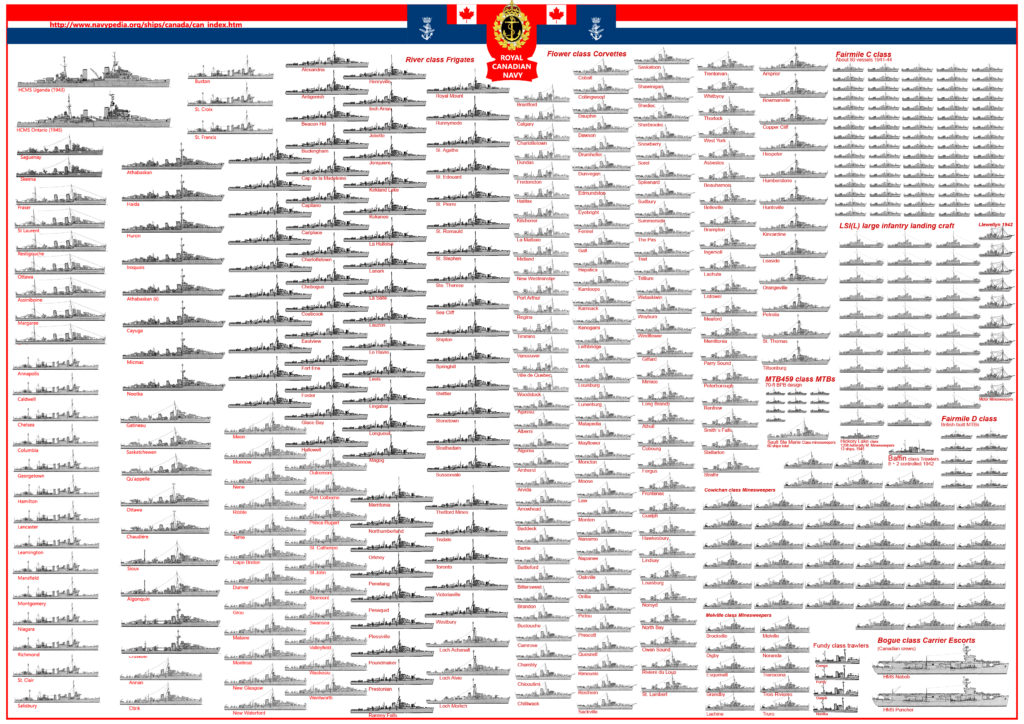
 Latest Facebook Entry -
Latest Facebook Entry -  X(Tweeter) Naval Encyclopedia's deck archive
X(Tweeter) Naval Encyclopedia's deck archive Instagram (@navalencyc)
Instagram (@navalencyc)





 French Navy
French Navy Royal Navy
Royal Navy Russian Navy
Russian Navy Armada Espanola
Armada Espanola Austrian Navy
Austrian Navy K.u.K. Kriegsmarine
K.u.K. Kriegsmarine Dansk Marine
Dansk Marine Nautiko Hellenon
Nautiko Hellenon Koninklije Marine 1870
Koninklije Marine 1870 Marinha do Brasil
Marinha do Brasil Osmanlı Donanması
Osmanlı Donanması Marina Do Peru
Marina Do Peru Marinha do Portugal
Marinha do Portugal Regia Marina 1870
Regia Marina 1870 Nihhon Kaigun 1870
Nihhon Kaigun 1870 Preußische Marine 1870
Preußische Marine 1870 Russkiy Flot 1870
Russkiy Flot 1870 Svenska marinen
Svenska marinen Søværnet
Søværnet Union Navy
Union Navy Confederate Navy
Confederate Navy Armada de Argentina
Armada de Argentina Imperial Chinese Navy
Imperial Chinese Navy Marinha do Portugal
Marinha do Portugal Mexico
Mexico Kaiserliche Marine
Kaiserliche Marine 1898 US Navy
1898 US Navy Sovietskiy Flot
Sovietskiy Flot Royal Canadian Navy
Royal Canadian Navy Royal Australian Navy
Royal Australian Navy RNZN Fleet
RNZN Fleet Chinese Navy 1937
Chinese Navy 1937 Kriegsmarine
Kriegsmarine Chilean Navy
Chilean Navy Danish Navy
Danish Navy Finnish Navy
Finnish Navy Hellenic Navy
Hellenic Navy Polish Navy
Polish Navy Romanian Navy
Romanian Navy Turkish Navy
Turkish Navy Royal Yugoslav Navy
Royal Yugoslav Navy Royal Thai Navy
Royal Thai Navy Minor Navies
Minor Navies Albania
Albania Austria
Austria Belgium
Belgium Columbia
Columbia Costa Rica
Costa Rica Cuba
Cuba Czechoslovakia
Czechoslovakia Dominican Republic
Dominican Republic Haiti
Haiti Hungary
Hungary Honduras
Honduras Estonia
Estonia Iceland
Iceland Eire
Eire Equador
Equador Iran
Iran Iraq
Iraq Latvia
Latvia Liberia
Liberia Lithuania
Lithuania Mandchukuo
Mandchukuo Morocco
Morocco Nicaragua
Nicaragua Persia
Persia San Salvador
San Salvador Sarawak
Sarawak Uruguay
Uruguay Venezuela
Venezuela Zanzibar
Zanzibar Warsaw Pact Navies
Warsaw Pact Navies Bulgaria
Bulgaria Hungary
Hungary

 Bundesmarine
Bundesmarine Dutch Navy
Dutch Navy Hellenic Navy
Hellenic Navy Marina Militare
Marina Militare Yugoslav Navy
Yugoslav Navy Chinese Navy
Chinese Navy Indian Navy
Indian Navy Indonesian Navy
Indonesian Navy JMSDF
JMSDF North Korean Navy
North Korean Navy Pakistani Navy
Pakistani Navy Philippines Navy
Philippines Navy ROKN
ROKN Rep. of Singapore Navy
Rep. of Singapore Navy Taiwanese Navy
Taiwanese Navy IDF Navy
IDF Navy Saudi Navy
Saudi Navy Royal New Zealand Navy
Royal New Zealand Navy Egyptian Navy
Egyptian Navy South African Navy
South African Navy






























 Ukrainian Navy
Ukrainian Navy dbodesign
dbodesign